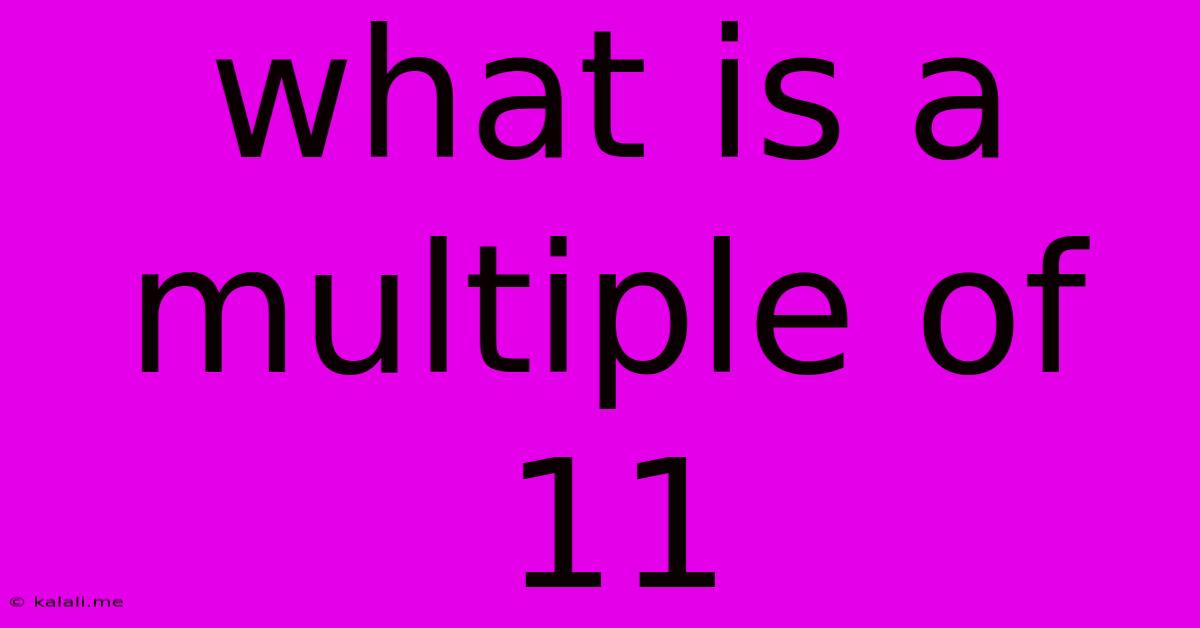What Is A Multiple Of 11
Kalali
May 09, 2025 · 3 min read

Table of Contents
What is a Multiple of 11? A Comprehensive Guide
Meta Description: Learn all about multiples of 11! This guide explains what multiples are, how to identify multiples of 11, and explores interesting patterns within these numbers. Perfect for students and anyone curious about number theory.
Multiples are fundamental in mathematics, forming the building blocks for understanding number relationships. Understanding multiples, particularly those of 11, opens doors to more advanced mathematical concepts. This article will provide a comprehensive explanation of what constitutes a multiple of 11, explore methods for identification, and delve into some of the intriguing patterns these numbers exhibit.
Understanding Multiples
Before focusing on multiples of 11, let's establish a clear definition of "multiple." A multiple of a number is the result of multiplying that number by any integer (whole number). For example, the multiples of 2 are 2, 4, 6, 8, 10, and so on (2 x 1, 2 x 2, 2 x 3, 2 x 4, 2 x 5...). Similarly, the multiples of 5 include 5, 10, 15, 20, 25, and so forth. The key is that a multiple is always a product of the original number and an integer.
Identifying Multiples of 11
Identifying multiples of 11 can be approached in several ways:
-
Direct Multiplication: The most straightforward method is simply multiplying 11 by various integers. This gives you a list of multiples: 11, 22, 33, 44, 55, 66, 77, 88, 99, 110, and so on.
-
Pattern Recognition: As you examine the multiples of 11, a pattern emerges. Notice the repeating pattern in the difference between consecutive multiples: 11 (difference of 11), 22 (difference of 11), 33 (difference of 11), and so on. This consistent difference is a defining characteristic of multiples.
-
Divisibility Rule: A handy trick for determining if a number is a multiple of 11 involves its digits. Let's consider a number like 121. We alternate adding and subtracting digits from right to left: 1 - 2 + 1 = 0. If the result is a multiple of 11 (including 0), the original number is also a multiple of 11. Let's try another example: 935. 5 - 3 + 9 = 11. Since 11 is a multiple of 11, 935 is a multiple of 11. This rule works for larger numbers as well. However, it's crucial to remember that the rule applies to numbers of any length.
Interesting Properties of Multiples of 11
Multiples of 11 possess some fascinating properties:
-
Pattern in Digits: The pattern in the digits of multiples of 11 is a repeating sequence, often mirrored or showing a symmetrical arrangement in larger numbers.
-
Mathematical Relationships: Multiples of 11 are intricately linked to other number systems and mathematical concepts, providing opportunities for further exploration in algebra and number theory.
-
Applications in Various Fields: Multiples of 11 appear in various fields, from computer science (in binary representations) to physics (in certain calculations).
Conclusion
Understanding multiples is a foundational element in mathematics. Learning how to identify and work with multiples of 11 enhances your mathematical skills and provides insights into the intricate relationships between numbers. By employing the methods discussed—direct multiplication, pattern recognition, and the divisibility rule—you can confidently determine whether a number is a multiple of 11 and unlock a deeper understanding of number theory.
Latest Posts
Latest Posts
-
How To Find The Upper Class Limit
May 09, 2025
-
Formation Of A Secondary Oocyte Occurs During
May 09, 2025
-
How Much Is 200ml In Ounces
May 09, 2025
-
Least Common Multiple Of 4 And 18
May 09, 2025
-
Which Is A Property Of Acids In Aqueous Solutions
May 09, 2025
Related Post
Thank you for visiting our website which covers about What Is A Multiple Of 11 . We hope the information provided has been useful to you. Feel free to contact us if you have any questions or need further assistance. See you next time and don't miss to bookmark.